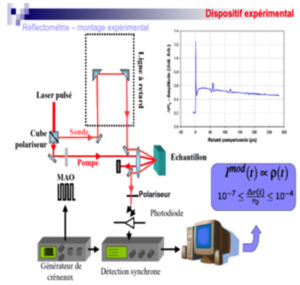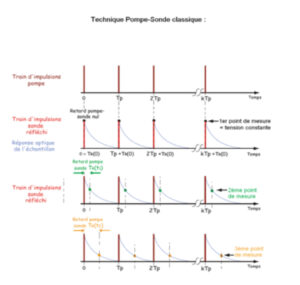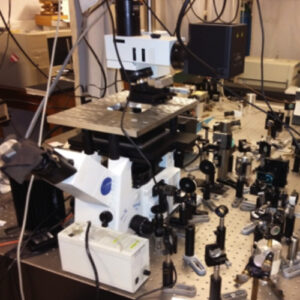List of members |
Facilities |
Internships and jobs |
PhD |
Publications |
News |
Material: 3 femtosecond lasers 80 MHz SpectraPhysics
- 2 cavities Tsunami 3W and 1W,
- 1 cavity Mai_Tai 2W,
- 1 OPO (Optical Parmetric Oscillator 500nm-1.6µm),
- 1 pulse picker doubler,
- 1 furnace for temperature study of metallic nanostructures (T°C up to 1200°C),
- 1 Oxford Cryostat Instrument for low temperature measurements on planar acoustic nanocavities.
This technique for all-optical generation and detection of acoustic phonons was developed in the 1980s by Humphrey Maris’ team at Brown University in the United States.
The absorption of a first femtosecond laser pulse called “pump” on an absorbent substrate (or on an absorbent thin film deposited on a transparent substrate) causes a sudden heating generating an elastic deformation propagating at the longitudinal or transverse speed of sound (depending on the initial deformation field) in the substrate.
This acoustic pulse is then reflected at an interface and finally leads to a surface displacement or a modification of the optical properties by photoelastic effect when it returns to the level of the generating surface. These 2 phenomena can be detected by reflectometry or interferometry measurements.
Acoustic pulses or vibrations are in fact detected by means of a second optically delayed laser pulse, “the probe”, by interferometric measurement of the changes in the optical reflectivity coefficient induced by the acoustic transients.
In order to obtain a time-resolved experiment, the time delay between the pump pulse and the probe pulse is usually controlled by the optical path difference between the two pulses using a Mechanical Delay Line (MDL). By controlling the optical path difference to the nearest millimeter, a time difference of less than one picosecond between the pump pulse and the probe pulse can be controlled.



Photo Assembly of picosecond acoustics coupled with an inverted Olympus microscope for the measurement of elastic properties of metallic nanostructures and biological cells.

